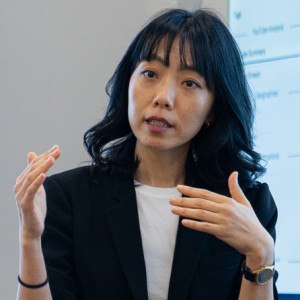Untrustworthy Hyperlinks on News Sites are Adding to the Misinformation Crisis
Trust

Misinformation is spreading rapidly in the digital universe, especially during election season, and the hyperlinks found on untrustworthy news sites may be partly to blame.
Jieun Shin, Ph.D., an assistant professor in the University of Florida College of Journalism and Communications Media Production, Management, and Technology Department, has been working with an interdisciplinary team to examine the patterns of embedding hyperlinks in suspicious websites. The team is conducting one of the first-ever studies about this hyperlinking behavior, which may shed new light on how false information spreads online.
“Hopefully our hyperlinking study becomes a piece that trains algorithms to detect misinformation better and more accurately,” said Shin, who co-authored the paper, “Real Connections in Fake News: Analysis of Linking Behaviors of Fake News Websites,” which has been under review for a journal publication. “The majority of hyperlinks on fake news sites go to other fake websites owned by the same family. We call it ‘in-family linking’ – one owner owns multiple fake news sites. It almost operates like a conglomerate.”
The fabricated news that is created by one site is then copied by other familial sites, which may add more details and cite those originating sites, Shin explained.
“These sites are run strategically and their hyperlinking behavior resembles gangsters,” Shin said. “If you identify two or three sites as gangster clusters, most fake sites belong to them. If you were a cop, you could bust three gangs and almost eliminate what looks like hundreds of fake news sites.”
There are some similarities between hyperlinking behavior on fake news sites and legitimately trustworthy sites; for example, both link to their own websites’ internal pages to keep their audiences as long as possible. But when trustworthy websites link to other websites, these sites are credible news sources that lead to reputable citations and more detailed information. That is not what fake news sites do, Shin said. Also, when rumors are passed along on fake news sites through hyperlinks, the content is transformed and often greatly exaggerated.
To dig deeper into why this is happening, Shin enlisted the expertise of colleagues in journalism, public relations, and computer science. The team includes Jessica Sparks, Ph.D., a UF alum and assistant professor of journalism at Auburn University; Renee Mitson, Ph.D., a UF alum and assistant professor of public relations at the University of Oregon; and Jean Louis, a Ph.D. candidate in computer science at UF who helped extract information from large data sets.
Having experts from different disciplines join the project led to invaluable insights, Shin said.
“Jessica and I are in journalism and know how the normative perspective should work. Renee is a public relations expert and understands strategic communication in organizations, including fake news sites,” Shin said. “John represented computer scientists, who are agnostic and blind to this normative aspect. They treat it like patterns. That blind-pattern recognition can bring a new perspective that we didn’t think about. It’s a win-win.”
Louis said the interdisciplinary approach to this study has been beneficial.
“Participating in this project allowed me to ask and investigate a question using different lenses,” Louis said. “It is an exchange of expertise to tackle a problem with real-world implications. We all leave with a new perspective to look at future problems in our respective disciplines.”
Shin hopes the team’s efforts to identify unusual online behavior will ultimately make an impact on the worldwide, widespread problem of misinformation.
“One paper wouldn’t solve this fake news problem and misinformation crisis,” Shin said. “But I hope our findings contribute to this global effort.”
Posted: September 17, 2024
Insights Categories:
Trust
Tagged as: Fake News, Jeiun Shin, Misinformation


